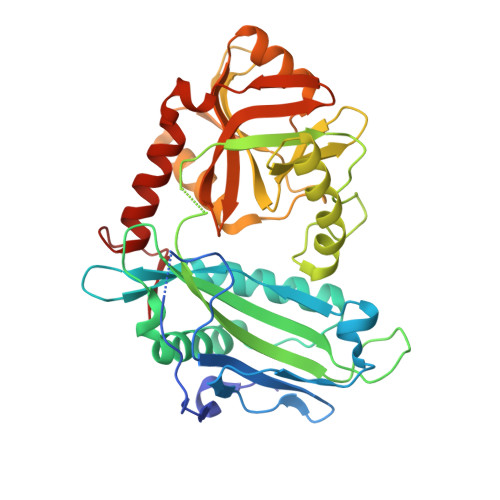The Discovery of in Vivo Active Mitochondrial Branched-Chain Aminotransferase (BCATm) Inhibitors by Hybridizing Fragment and HTS Hits.
Bertrand, S.M., Ancellin, N., Beaufils, B., Bingham, R.P., Borthwick, J.A., Boullay, A.B., Boursier, E., Carter, P.S., Chung, C.W., Churcher, I., Dodic, N., Fouchet, M.H., Fournier, C., Francis, P.L., Gummer, L.A., Herry, K., Hobbs, A., Hobbs, C.I., Homes, P., Jamieson, C., Nicodeme, E., Pickett, S.D., Reid, I.H., Simpson, G.L., Sloan, L.A., Smith, S.E., Somers, D.O., Spitzfaden, C., Suckling, C.J., Valko, K., Washio, Y., Young, R.J.(2015) J Med Chem 58: 7140-7163
- PubMed: 26090771
- DOI: https://doi.org/10.1021/acs.jmedchem.5b00313
- Primary Citation of Related Structures:
5BWR, 5BWT, 5BWU, 5BWV, 5BWW, 5BWX - PubMed Abstract:
The hybridization of hits, identified by complementary fragment and high throughput screens, enabled the discovery of the first series of potent inhibitors of mitochondrial branched-chain aminotransferase (BCATm) based on a 2-benzylamino-pyrazolo[1,5-a]pyrimidinone-3-carbonitrile template. Structure-guided growth enabled rapid optimization of potency with maintenance of ligand efficiency, while the focus on physicochemical properties delivered compounds with excellent pharmacokinetic exposure that enabled a proof of concept experiment in mice. Oral administration of 2-((4-chloro-2,6-difluorobenzyl)amino)-7-oxo-5-propyl-4,7-dihydropyrazolo[1,5-a]pyrimidine-3-carbonitrile 61 significantly raised the circulating levels of the branched-chain amino acids leucine, isoleucine, and valine in this acute study.
Organizational Affiliation:
GlaxoSmithKline R&D, Medicines Research Centre , Gunnels Wood Road, Stevenage, Hertfordshire SG1 2NY, U.K.





















